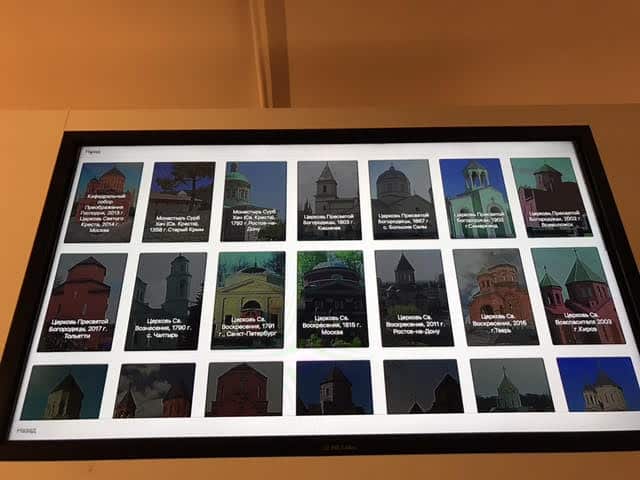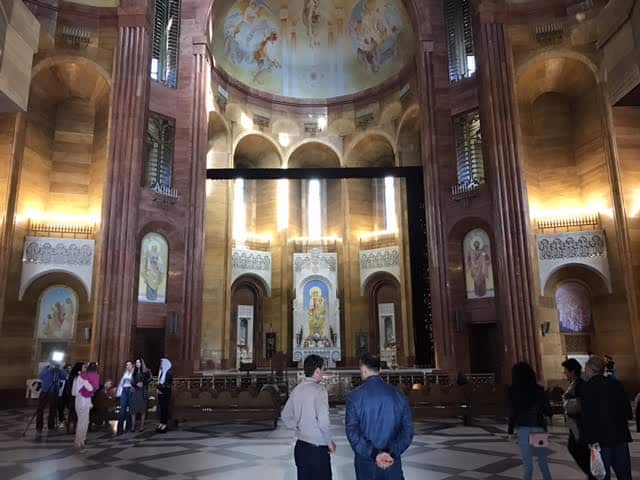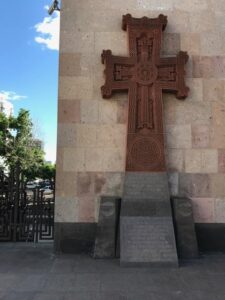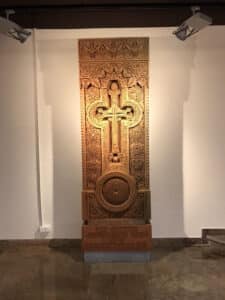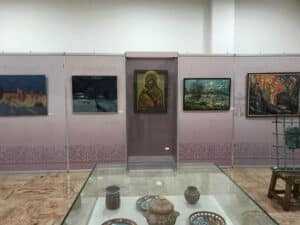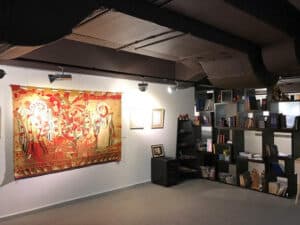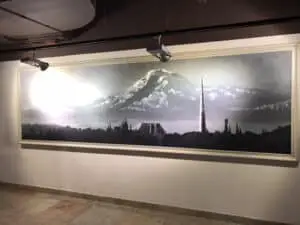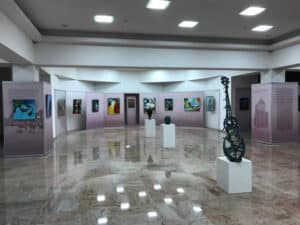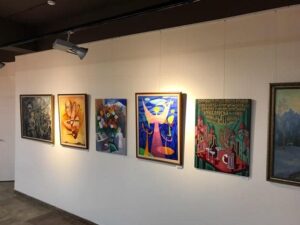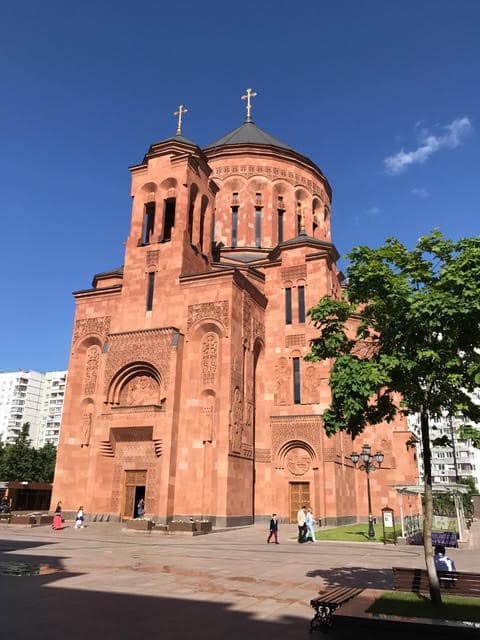 The Armenian Temple Complex is a collection of buildings in the north side of Moscow. The large 500-meter-long square property contains an Armenian restaurant, a community center, a collection of various monuments, a museum, and the Holy Transfiguration Cathedral – the largest Armenian Apostolic Church outside of Armenia. The complex was designed to be a haven for Armenians, serving as both a cultural and spiritual center for the ever-growing Armenian community of Moscow. While the official count of Russian-Armenians in Moscow is just over 100,000, it is estimated that as many as one million people of some Armenian descent live within the city limits. The temple complex was funded entirely by large donations from a group of wealthy Armenians in the diaspora to the Armenian Diocese in Moscow. The cathedral and monuments around the complex were completed in 2013, and the museum completed construction in 2015.
The Armenian Temple Complex is a collection of buildings in the north side of Moscow. The large 500-meter-long square property contains an Armenian restaurant, a community center, a collection of various monuments, a museum, and the Holy Transfiguration Cathedral – the largest Armenian Apostolic Church outside of Armenia. The complex was designed to be a haven for Armenians, serving as both a cultural and spiritual center for the ever-growing Armenian community of Moscow. While the official count of Russian-Armenians in Moscow is just over 100,000, it is estimated that as many as one million people of some Armenian descent live within the city limits. The temple complex was funded entirely by large donations from a group of wealthy Armenians in the diaspora to the Armenian Diocese in Moscow. The cathedral and monuments around the complex were completed in 2013, and the museum completed construction in 2015.
The Armenian Monuments
There are several small monuments to Armenia that are scattered throughout the temple complex. The largest is the Armenian Genocide Centennial monument. Installed in 2015, the monument commemorates the 100th year anniversary of the Armenian Genocide. The monument is in the shape of an ancient Armenian crest, is over 10 feet tall, and has the numbers 1915 on top of the crest to represent the first year of the genocide. Next to it, close to the entrance, is another genocide memorial in the shape of an Armenian cross. There is an inscription on the bottom in Armenian calling for “peace on earth” for all people. Identical monuments can be found in Armenian sanctuaries in other countries as well, and are a commonality across the increasingly large and global diaspora. The presence of such monuments in the complex connects the Muscovite Armenian community to the other Armenian communities of the world: a goal of the greater Armenian diaspora.
The Holy Transfiguration Cathedral
The Holy Transfiguration Cathedral is not only the largest Armenian Apostolic Church in Russia, but serves as the seat of the Armenian Diocese in Russia. The massive crimson-bricked structure attracts attention from afar, and can be seen from many blocks away. It is open to the public every day of the week for prayer and confession services. Many Armenians come to the church to light candles, view the architecture, and talk to ministers, who spend most of their time in the cathedral.
Inside the cathedral, there are three large enclaves with three smaller enclaves within them. Each enclave contains a picture – some contain pictures of God the Father and Mary, while others contain pictures of Armenian children praying and Armenian saints. The domes of the cathedral all display pictures of saints and angles, with God the Father being depicted in the highest dome. While Armenian Apostolic Cathedrals aren’t known to have as many icons as their Eastern Orthodox counterparts, the geometry of the building makes for a unique arrangement of alters, icons, and figures. No other church in the world has this architecture, making the Holy Transfiguration Cathedral a sight to see.
The Armenian Museum of Moscow
The Armenian Museum of Moscow lies below the cathedral and is accessible from a staircase in the center of the temple complex leading below ground. The first exhibit of the museum is a series of contemporary works of art by Armenian artists. Most of the paintings on display are either of Armenia, Armenians, or historically important events in Armenia, and are oil paintings – a popular style of painting in Armenia. A significant number of paintings are of the iconic Mount Ararat, one of the largest mountains in Ancient Armenia that overlooks Yerevan. While the mountain is currently located in present-day Turkey, it remains both a cultural and spiritual symbol for Armenians.
On a floor slightly above the painting is an open library of documents, books, and cultural artifacts related to Armenia. The library is free to use at all times, and contains an extensive list of historical documents related to Armenian history in Russia. A series of books including Russian-Armenian Dictionaries, the history of the Armenian language, and Armenian culture books are spread out across several different bookshelves. All of the books and novelty items are written in either Armenian or Russian. The space also doubles as an education center for Armenian children on weekends, in an effort to encourage religious and cultural education. The facility helps to encourage Armenian identity while also encouraging the perception of Armenians as having a natural place in Russian society.
The biggest section of the museum is the relics exhibit, where dozens of ancient Armenian artifacts are kept, along with several documentaries playing that talk about the artifacts’ histories. Armenian chalices, crosses, ceremonial robes, bibles, fans, staffs, medallions, and maps are on display in a large glass case. Many of the artifacts are from 0 AD to 1000 AD, and were recovered from sites in Old Armenia, such as parts of modern day Turkey, Armenia, and Azerbaijan. They are considered to be treasures to the Armenian community in both Moscow and abroad. The section also contains a running list of all the Armenian monasteries and relics in Russia, as well as individual information on each of them. The vast array of knowledge on other Armenian communities spanning from Saint-Petersburg to Vladivostok is a testament to the strength of the community in Russia. In between the two cases of artifacts lies a quote from the head of the patriarch of the Russian Orthodox Church in 2015, declaring the new Armenian Cathedral to be a strengthening of ties between the Russian and Armenian communities. At the end of the museum is an exhibit in development to be focused on specific contributions of Armenians to Moscow specifically. The exhibit is scheduled to open next year.
